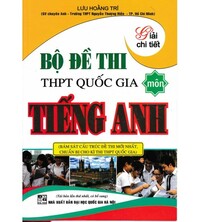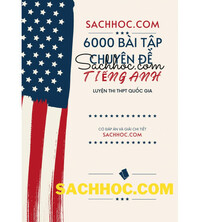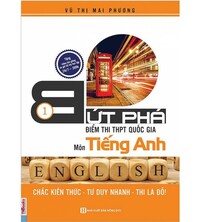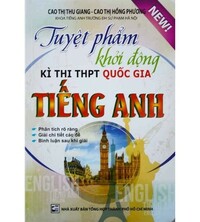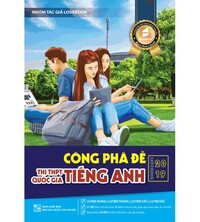Đề ôn thi THPT Quốc gia môn tiếng Anh
Tìm Đáp Án xin giới thiệu đến các bạn Đề thi thử THPT Quốc gia môn Tiếng Anh năm 2018 có đáp án + giải thích chi tiết (Đề số 12) được sưu tầm và đăng tải dưới đây là nguồn tài liệu hữu ích dành cho các bạn ôn thi kì thi THPT Quốc gia đang đến rất gần. Sau đây mời các bạn vào tham khảo.
ĐỀ THI GỒM 50 CÂU (TỪ QUESTION 1 ĐẾN QUESTION 50)
Mark the letter A, B, C, or D on your answer sheet to indicate the word that is closest in meaning to the underlined part in each of the following questions.
Question 1. The aircraft carrier is indispensable in naval operations against sea or shore based enemies.
A. unique B. novel C. exotic D. vital
Question 2. The use of lasers in surgery has become relatively commonplace in recent years.
A. absolutely B. relevantly C. almost D. comparatively
Mark the letter A, B, C, or D on your answer sheet to indicate the word that is opposite in meaning to the underlined part in each of the following questions.
Question 3. It was a heartfelt apology.
A. loving B. insincere C. unhealthy D. humorous
Question 4. A trial must be fair and impartial.
A. hostile B. biased C. unprejudiced D. apprehensive
Mark the letter A, B, C, or D on your answer sheet to indicate the word that differs from the rest in the position of the main stress in each of the following questions.
| Question 5. | A. contaminate | B. artificial | C. intelligent | D. encouragement |
| Question 6. | A. argument | B. difference | C. employee | D. category |
Mark the letter A, B, C, or D on your answer sheet to show the underlined part that needs correction
Question 7. It is time the government do something to help the unemployed to find some jobs.
A B C D
Question 8. I enjoy reading the article that you told me about it yesterday.
A B C D
Question 9. Many languages used around the world they do not have a form of writing.
A B C D
Read the following passage and mark the letter A, B, C or D on your answer sheet to indicate the correct answer to each of the following questions from 10 to 14.
In the world today, particularly in the two most industrialized areas, North America and Europe, recycling is big news. People are talking about it, practicing it, and discovering new ways to be sensitive to the environment. Recycling means finding was to use products a second time. The motto of the recycling movement is "Reduce, Reuse, Recycle".
The first step is to reduce garbage. In stores, a shopper has to buy products in blister packs, boxes and expensive plastic wrappings. A hamburger from a fast food restaurant comes in lots of packaging: usually paper, a box, and a bag. All that packaging is wasted resources. People should try to buy things that are wrapped simply, and to reuse cups and utensils. Another way to reduce waste is to buy high-quality products. When low quality appliances break, many customers throw them away and buy new ones - a loss of more resources and more energy. For example, if a customer buys a high-quality appliance that can be easily repaired, the manufacturer receives an important message. In the same way, if a customer chooses a product with less packaging, that customer sends an important message to the manufacturers. To reduce garbage, the throwaway must stop.
The second step is to reuse. It is better to buy juices and soft drinks in returnable bottles. After customers empty the bottles, they return them to the store. The manufacturers of the drinks collect the bottles, wash them, and then fill them again. The energy that is necessary to make new bottles is saved. In some parts of the world, returning bottles for money is a common practice. In those places, the garbage dumps have relatively little glass and plastic from throwaway bottles.
The third step is being environmentally sensitive is to recycle. Spent motor oil can be cleaned and used again. Aluminum cans are expensive to make. It takes the same amount of energy to make one aluminum can as it does to run a color TV set for three hours. When people collect and recycle aluminum (for new cans), they help save one of the world's precious resources.
Question 10. What is the main topic of the passage?
A. How to reduce garbage disposal
B. What people often understand about the term 'recycle'
C. What is involved in the recycling movement
D. How to live sensitively to the environment
Question 11. People can do the following to reduce waste EXCEPT:
A. buyhigh-quality product B. buy simply-wrapped things
C. reusecups D. buy fewer hamburgers
Question 12. Why is it a waste when customers buy low-quality products?
A. Because people will soon throw them away.
B. Because they have to be repaired many times.
C. Because customers change their ideas all the time
D. Because they produce less energy.
Question 13. What best describes the process of reuse?
A. The bottles are collected, washed, returned and filled again.
B. The bottles are filled again after being returned, collected and washed.
C. The bottles are washed, retuned, filled again and collected.
D. The bottles are collected, returned filled again and washed.
Question 14 What are the two things mentioned as examples of recycling?
A. Aluminum cans andplastic wrappings. B. Hamburger wrappings and spent motor oil.
C. Aluminum cans and spent motor oil. D. TV sets and aluminum cans.
Read the following passage and mark the letter A, B, C, or D to indicate the best option for each of the blanks.
If you're an environmentalist, plastic is a word you tend to say with a sneer or a snarl. It has become a symbol of our wasteful, throw-away society. But there seems little doubt it is here to stay, and the truth is, of course, that plastic has brought enormous (15)__________, even environmental ones. It's not really the plastics themselves that are the evil ─ it's the way society chooses to use and (16)_______ them.
Almost all the 50 or so different kinds of modern plastic are made from oil, gas or coal - non-renewable natural (17)______. We (18)_______ well over three million tones of the stuff in Britain each year and, sooner or later, most of it is thrown away. A high (19)_______ of our annual consumption is in the form of packaging, and this (20)________ about seven percent by weight of our domestic refuse.
| Question 15. | A. savings | B. pleasures | C. benefits | D. profits |
| Question 16. | A. abuse | B. endanger | C. store | D. dispose |
| Question 17. | A. processes | B. resources | C. products | D. fuels |
| Question 18. | A. import | B. consign | C. remove | D. consume |
| Question 19. | A. amount | B. proportion | C. portion | D. rate |
| Question 20. | A. makes | B. carries | C. takes | D. constitutes |
Đáp án Đề thi thử THPT Quốc gia môn tiếng Anh năm 2018
1. D
- unique (adj): độc đáo, độc nhất
- novel (adj): mới mẻ, độc đáo
- exotic (adj): kỳ lạ, có tính ngoại
- vital (adj) = indispensable (adj): quan trọng, thiết yếu
2. D
- absolutely (adv): một cách chắc chắn, tuyệt đối
- relevantly (adv): một cách liên quan, thích hợp
- almost (adv): gần như, hầu như
- comparatively (adv) = relatively (adv): một cách tương đối
3. B
- loving (adj): yêu quý, giàu tình cảm
- insincere (adj): không chân thành, giả dối >< heartfelt (adj): chân thành
- unhealthy (adj): không khoẻ mạnh; không lành mạnh
- humorous (adj): hài hước
4. B
- hostile (adj): thùđịch
- biased (adj): thiên vị >< impartial (adj): công bằng, khách quan, không thiên vị
- unprejudiced (adj): khách quan, không định kiến
- apprehensive (adj): hồi hộp, lo sợ
5. B
- con'taminate (v): gây ônhiễm
- arti'ficial (adj): nhântạo
- in'telligent (adj): thôngminh
- en‟couragement (n): sự động viên, sự khích lệ
6. C
- „argument (n): sự tranh luận/ cuộc tranh luôn
- „different (adj): khác nhau
- em‟ployee (n): nhân viên
- „category (n): thể loại
7. B
Cấu trúc : It‟s (high) time sb did sth Chữa lỗi: do -> did
Dịch : Đã tới lúc chính phủ làm gì đó để giúp đỡ những người thất nghiệp tìm việc làm.
8. D
Chữa lỗi: bỏ “it”
Dịch: Tôi thích đọc bài báo mà cậu đã kể với tôi hôm qua.
9. C
Bỏ “they”
Cấu trúc của câu:
S: Many languages used around the world V: do not have
O: a form of writing
Dịch: Nhiều ngôn ngữ được sử dụng trên toàn thế giới không có dạng viết.
10. C
Trong bài, tác giả kể ra 3 bước (The first step, The second step, The third step) của “the recycling movement” (phong trào tái chế).
Mời các bạn tiếp tục vào tham khảo đề thi môn Tiếng Anh THPT Quốc gia năm 2017 Bộ GD-ĐT công bố đáp án là Đề thi chính thức đã thi gần đây nhất sẽ giúp các bạn đánh giá tốt nhất năng lực kiến thức của bản thân để lên kế hoạch học tập và ôn luyện, yên tâm bước vào kì thi quan trọng này. Chúc các bạn thi tốt!

